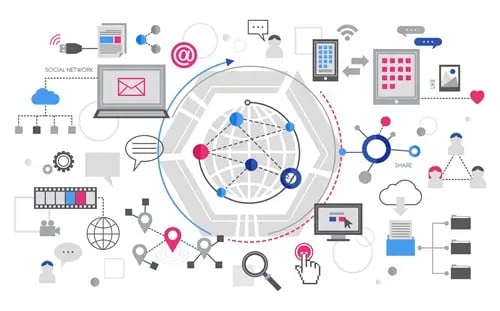Cloudficient: From Good (2022) to Great (2023)
Read about our successes in 2022, and our plans for 2023 and beyond
-3.png?width=250&height=33&name=Untitled%20design%20(18)-3.png)
The first few months of 2024 have shown that this year will bring rapid innovation in the enterprise software as a ...
The first few months of 2024 have shown that this year will bring rapid innovation in the enterprise software as a service (SaaS) market. The rise of commercial-grade artificial intelligence transformed this sector in 2023. AI continues to be a driving force for enterprise SaaS products alongside several other emerging trends. Learn more about five SaaS 2024 predictions and find out how cloud transformation can enable your organization to benefit from these advances.
Here are five market forces we expect to shape the enterprise SaaS market this year.

AI revolutionized the state of SaaS products in 2023 with the increasing availability of large language models or LLMs. Microsoft was quick to invest in Open AI and incorporate Chat GPT into the Bing search engine and Microsoft 365. This trend is on track to accelerate in 2024. In a recent survey of over 1,000 technology professionals, 40% of participants considered AI a trend to watch in 2024, up from 15% in 2023.
This year, Microsoft is focusing on providing tools to developers through Azure AI. A model as a service or MaaS approach will allow for the integration of AI into more enterprise applications. This trend is also driving innovation at large cloud providers, including Amazon Web Services, which offers a variety of fully managed AI services to lower the barriers to innovation.
SaaS products powered by AI will continue to make producing deliverables easier and faster for enterprise users. More advanced integrations of AI and machine learning technology have the potential to free users up to focus on high-level work and supply the most relevant data to inform any project.
Our second SaaS 2024 prediction involves the increasing prevalence of data as a service or DaaS solutions. These tools allow for more efficient data management in the cloud and extend from accessibility to analytics. Cloud onboarding is the first step towards benefitting from these advancements.
Microsoft announced Fabric, an end-to-end analytics platform, back in May 2023. Fabric integrates Azure Data Factory, Azure Synapse Analytics and Power BI into a single environment. We predict that Microsoft Fabric and similar offerings from other cloud providers will lead to further innovations in the SaaS market for cloud-based data management and BI.
Over 90% of companies currently rely on cloud-based infrastructure in some capacity. Essential data for operations and analysis is often stored in the cloud. Providers and SaaS developers will continue to find ways to increase the accessibility of this data. Market research estimates the value of the global DaaS market to be $20.74 billion in 2024 and predicts the value of this sector will exceed $50 billion by the end of the decade.
Edge computing is a recent trend that has a long history. The concept of content delivery networks dates back to the late 1990s, but the availability of faster networks and compact processors has led to a resurgence of this model. Edge computing allows for data processing near the source rather than relying exclusively on centralized cloud servers.
Some of the benefits of edge computing for SaaS in 2024 include:
Edge computing works best in combination with cloud services, meaning that edge-to-cloud interfaces are likely to be an area of significant advancement in 2024 and beyond.
The edge model connects devices and equipment, such as sensors, to nearby servers called gateways. Edge gateways act as intermediaries between these devices and cloud services, performing some processing functions locally and transferring data to the cloud. Information technology decision makers at enterprises can choose from a growing selection of apps and services that provide edge-to-cloud interoperability and some key benefits of hybrid cloud configurations.

We predict that platform as a service or PaaS tools will play an important part in shaping enterprise SaaS 2024 development. These frameworks support the development and deployment of web apps and provide the advantages of availability and scalability associated with cloud environments.
Similar to the availability of ready-built and managed AI models, PaaS providers include tools and built-in components to expedite app development. These pre-coded components can range from directory services to search and security features. PaaS plans include infrastructure and an integrated environment for the app lifecycle, from development, testing and deployment through ongoing management and updates.
PaaS tools are typically available under pay-as-you-go models that can make these development options widely accessible. It is noteworthy that apps built on these platforms are only available to tenants of the same cloud service provider as the vendor. The PaaS trend should significantly increase the number of cloud-based SaaS solutions available to enterprise users in 2024.
All of the large cloud service providers have track records of acquiring companies to provide more services and features to tenants. Any attempt to make 2024 SaaS predictions must account for ongoing consolidation under hyperscalers. This is especially the case for companies in sectors in which we predict rapid growth, including AI, DaaS and edge computing. SaaS developers who use proprietary PaaS tools also limit usage of the apps that they create to tenants of their providers.
The trend toward market consolidation will sometimes have visible effects and other times less visible effects for enterprise users. For example, Microsoft’s acquisition of data processing unit maker Fungible Inc. has technical implications but is unlikely to noticeably impact user experience. Acquisitions of enterprise SaaS companies and cloud provider-exclusive PaaS apps can determine the availability and compatibility of enterprise solutions. Market consolidation also affects which services are available in cloud environments. Google’s acquisition of edge software provider MobiledgeX illustrates the potential effects of these transactions.
Prior to the sale of MobiledgeX, the Edge-Cloud platform developed by this company had recently introduced federation, or compatibility across mobile network environments. MobiledgeX worked with many mobile operators and all of the leading cloud providers. The acquisition of this company by a single hyperscaler limits the availability of the platform. Information technology decision makers at enterprises should consider the continuity of software and services and keep apprised of changes.

The enterprise SaaS market is rapidly growing and constantly changing. You can give your organization a competitive edge by staying up to date on the latest advances and weighing the potential impact of SaaS 2024 developments on infrastructure and workflows.
With unmatched next generation migration technology, Cloudficient is revolutionizing the way businesses retire legacy systems and transform their organization into the cloud. Our business constantly remains focused on client needs and creating product offerings that match them. We provide affordable services that are scalable, fast and seamless.
If you would like to learn more about how to bring Cloudficiency to your migration project, visit our website, or contact us.
Read about our successes in 2022, and our plans for 2023 and beyond
Technology leads to new advances every year, along with benefits (and caveats) to be aware of. Learn the latest eDiscovery trends to look forward to...
The leading eDiscovery platforms and cloud services are scaling to meet increased demand. Learn more about how these platforms process growing...